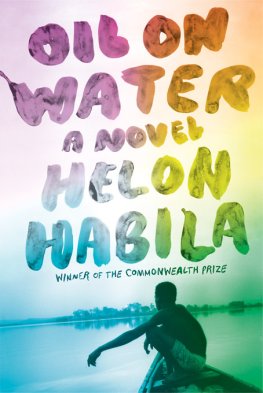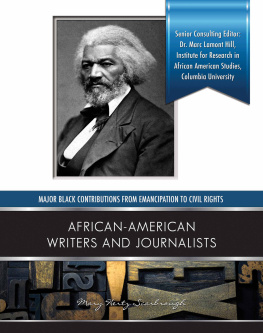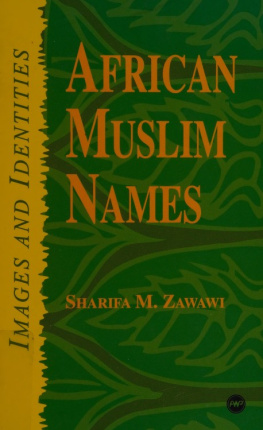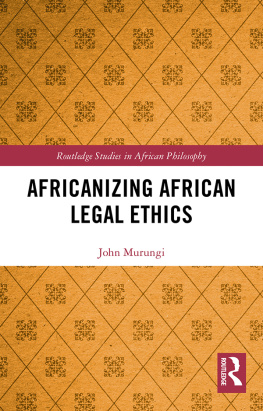AFRICAN VISIONARIES
Translated into English by
MARY ESTHER KROPP DAKUBU
&
EVA MARIA ASANTE
edited by
Agnes Ofosua Vandyck,
Molly Nyagura & Rosemary Brooks
Original German version edited by
M. MOUSTAPHA DIALLO
First Published in Ghana 2019
by Sub-Saharan Publishers
P.O.Box 358
Legon-Accra
Ghana
Email:
of this English edition SUB-SAHARAN PUBLISHERS 2019
ISBN 978-9988-8829-9-0
Copyright Notice
No part of this publication may be reproduced, stored in a retrieval system or transmitted in any form or by any means electronic, mechanical, photocopying, recording or otherwise, without the prior written permission of the University of Ghana or the publishers.
DEDICATION
To the loving memory of
Emeritta Professor Mary-Esther Kropp-Dakubu
We have bought the English language rights to childrens books in other languages but never an adult one. The first adult book in German we had translated was DIE EWE STMME by Jocob Spieth; a very serious piece of work and we came out with flying colours; the Goethe Institut and the German Embassy in Accra were delighted with the work and they financially supported it.
The translation of VISIONRE AFRIKAS has been quite a challenging experience. Firstly, the original translator, Mary-Esther Kropp-Dakubu, (may she rest in peace), passed away unexpectedly, after translating about half of the work. Getting someone to complete the translation became a headache. Eventually we contacted Eva Maria Asante, a German language teacher at the Goethe Institut, to complete the translation.
Then we had to find editors to edit the translation. That too was a drag; in fact we feared Peter Hammer Verlag might even withdraw the rights because it was expected that the English version would come out two years after the purchase of the rights. Well, it has taken four years! Editing diverse papers, originally written in a myriad of languages, but translated into German, and now into English, is no mean task.
Our sincere thanks to Agnes Ofosua Vandyck of Ghana and Molly Nyagura of Zimbabwe for doing meticulous editing; and to Rosemary Brooks of Oxford, for her help in checking the final proofs. The portraits described in the collection are varied and extremely interesting.
Now the book is available in English and thus to a wider audience.
Akoss Ofori-Mensah
MANAGING DIRECTOR.
If the hare only listens to what the hyena is saying, it will never know what the buffalo is really like.
By means of such proverbs, African people like to underscore the value of a personal narrative or the influence of someones perspective on the perception of another person. This advice is nowhere else more justified than in the case of Africa. Even today, this continent is seen in Europe from a viewpoint which is very much subject to stereotypes and prejudices. It is reduced to wars, diseases and catastrophes. Even today, in the 21st century, African women and African men only very rarely get the chance to speak in Europe. This book should change this. About forty female and male authors from Africa came together to try and show an authentic picture of their continent, of its diversity and vitality. This can definitely be best achieved by taking a close look at the people. Therefore, every author portrayed a personality from the African past or present, who is important for himself or herself. They are personalities, who are, or were, engaged in shaping their community, their village or their country according to their own ideas.
This book would not have been possible without the modern communication media. With the help of the internet, we were able to present our ideas to many African authors from different countries in Africa but also from Europe, the USA and Canada. Many have encouraged us to continue with our plans, sent us suggestions spontaneously and participated. Often, they had problems with weak and slow internet connections, so that it was not always easy to transmit data and to meet deadlines. But finally, 42 portraits were collected, and I would like to take this opportunity to express my greatest thanks to all the authors who participated.
Who is portrayed? It is inevitable that the selection is subjective, because it is based on the suggestions of the authors. We do not intend to claim that the book is complete; it would be rather sobering, if every personality in question could find space in one book. Not all people portrayed are famous personalities. But something else is much more decisive: all the people the book tells us about, did not want or do not want to accept their fates. They had and have a vision of a better life for themselves and their fellow human beings. The vitality of Africa comes to light in the forty-two portraits from twenty-three countries, which range from Yennenga, who founded the kingdom of the Mossi, to our contemporary era. These are true stories about women and men, who tell us about dignity in human life; about the complexity, the dreams and the disillusions; about victories and defeats; about the long-lasting struggle for autonomy and the longing for the political unity of all Africans. They also tell us about the close relations between Africa and Europe, which have been shaping the daily lives of Africans for centuries already. One can read about Africans who were abducted to Europe and who achieved something remarkable over there, as well as about musicians, writers, visual artists, resistance fighters, politicians, feminists, civil rights campaigners, progressive thinkers and inventors, who changed the history of present day Africa.
The African women and men who are portrayed in this book, wanted to realise their dreams in their lives. It started with the dream of the provision of clean water but did not end with the dream of a just society. All of them used all of their abilities and their energy to make their dreams come true. May their dreams and their engagement be an inspiration for us.
M. Moustapha Diallo
Finally, after a long time of preparation, the book is ready: The Visionaries of Africa The Continent in Extraordinary Portraits! Forty African authors wrote forty-two portraits about African women and men they consider important. In the end, it came to more than three hundred pages. Such an undertaking cannot be accomplished without the cooperation of numerous persons and institutions. This book would have hardly been published without their unselfish support. To all of them, I say a heartfelt thank you.
Foremost, I would like to thank the Peter Hammer publishing house with its publishing director Monika Bilstein, who included The Visionaries of Africa as a matter of course in the programme for African literature. And I would like to express my gratitude to the Peter Hammer Association for Literature and Dialogue (registered association), who assisted with the creation of the book with help and advice. Hermann Schulz generously allowed me to profit from his years of experience in book-making. Gudrun Honke offered her years of experience in editing African literatures to the portraits. Many thanks to the two of you for this!
Not least, such an undertaking also requires financial support. The Peter Hammer Association for Literature and Dialogue, Wuppertal; the North-Rhine Westphalian Foundation for Environment and Development, Bonn; the Municipal Savings Bank in Wuppertal and the Circle of Friends Bagamoyo, (registered association), Bockum, deserve particular thanks here.










